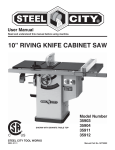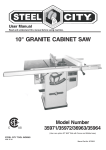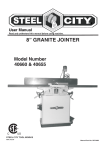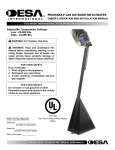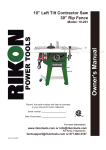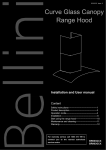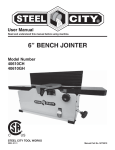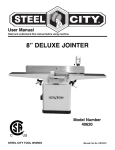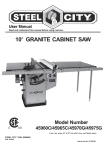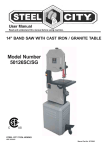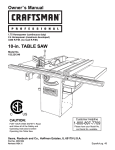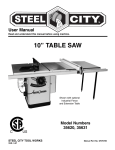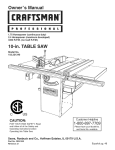Download 35920 - 10" Granite Cabinet Saw - Steel City Tool Works
Transcript
R 10" GRANITE CABINET SAW Model 35920 Shown Model Number 35929 35920 STEEL CITY TOOL WORKS VER. 12.08 Manual Part No. SC75009 TABLE OF CONTENTS INTRODUCTION SECTION 1 Warranty ........................................................................................................................................4 SECTION 2 Product Specifications ...................................................................................................................7 SECTION 3 Accessories and Attachments ........................................................................................................8 SECTION 4 Definition of Terms..........................................................................................................................8 SECTION 5 Feature Identification .....................................................................................................................9 SECTION 6 General Safety..............................................................................................................................10 SECTION 7 Product Safety .............................................................................................................................12 SECTION 8 Electrical Requirements................................................................................................................13 SECTION 9 Grounding Instructions .................................................................................................................14 SECTION 10 Unpacking & Inventory..................................................................................................................15 SECTION 11 Assembly .....................................................................................................................................17 SECTION 12 Adjustments..................................................................................................................................24 SECTION 13 Operations ...................................................................................................................................29 SECTION 14 Maintenance ................................................................................................................................34 SECTION 15 Troubleshooting Guide..................................................................................................................35 SECTION 16 Parts ...........................................................................................................................................36 INTRODUCTION This user manual is intended for use by anyone working with this machine. It should be kept available for immediate reference so that all operations can be performed with maximum efficiency and safety. Do not attempt to perform maintenance or operate this machine until you have read and understand the information contained in this manual. The drawings, illustrations, photographs, and specifications in this user manual represent your machine at time of print. However, changes may be made to your machine or this manual at any time with no obligation to Steel City Tool Works. 3 Model No. 35929 Model No. 35920 Motor Induction Induction HP 1.75 1.75 Amps 15 / 7.5 15 / 7.5 Volts 120 / 240 120 / 240 Hertz 60 60 RPM 3450 3450 Blade Tilt Left Left Blade Drive Poly-V Belt Poly-V Belt Blade Diameter 10-in 10-in Blade Arbor 5/8-in 5/8-in Number of Teeth 40 40 Blade Speed 3450 3450 Max Depth of Cut at 90° 3-3/8-in 3-3/8-in Max Depth of Cut at 45 2-1/4-in 2-1/4-in Table in front of blade At max Depth of Cut Max Dado Width 12-1/2-in 12-1/2-in 13/16-in 13/16-in Extension Wings 12-in Granite(2) 12-in Granite(2) 40" 27" 37" 403lb 40" 27" 37" 437.6lb PRODUCT DIMENSIONS Length Width Height Net Weight SHIPPING DIMENSIONS: Length 30" 38" Width 29.5" 29.5" Height 42.7" 42.7" Gross Weight 430lb 469.5lb 7 ACCESSORIES AND ATTACHMENTS There are a variety of accessories available for your Steel City Product. For more information on any accessories associated with this and other machines, please contact your nearest Steel City distributor, or visit our website at : www.steelcitytoolworks.com. DEFINITION OF TERMS Kerf – The material removed from the workpiece by the blade during any cutting operation. Anti-Kickback Fingers – A safety device attached to the blade guard and splitter assembly designed to minimize the chance of a workpiece being thrown back during a cutting operation. Kickback – When the workpiece is thrown back toward the operator at a high rate of speed during a cutting operation. Arbor – The shaft on which the blade or accessory cutting-tool is mounted. Riving Knife-The same as splitter-it prevents the slot cut into kerf from closing behind the blade on a rip. Also the clearance between riving knife and blade will be consistent when raising or lowing blade. Bevel Cut – The operation of making any cut with the blade set at an angle other than 90 degrees. Compound Cut – The operation of making both a bevel and a miter cut at one time. Miter Cut – The operation of making a cut using the miter gauge at any angle other than zero degrees. Crosscut – The operation of making a cut across the grain or width of a workpiece. Push Stick – An accessory device that can be made or purchased to help push the workpiece through the blade. A push stick is used to keep the operator hands away from the blade when ripping a narrow workpiece. Dado – A non-through cut that produces a square notch. A dado is typically from 1/8-in. to 13/16-in. wide. A dado requires a special set of blades, not included with this table saw. Rabbet – A square notch in the edge of the workpiece. Featherboard – An accessory device that can be made or purchased to help guide or hold down a workpiece during cutting operations. Rip Cut – The operation of making a cut with the grain or down the length of the workpiece. Saw Blade Path – The area that is directly in line with the blade, including area over, under, behind and in front of it. Freehand – A very dangerous operation of making a cut without using the fence or miter gauge in a cutting operation. FREEHAND CUTS MUST NEVER BE PERFORMED ON A TABLE SAW. Set of the Saw Blade – The distance that the tips of the saw blade are angled outwards from the thickness of the blade. Gum, Pitch or Resin – A sticky, sap based residue that comes from wood products. Table/Work Area – The total surface of the top of the table saw on which the workpiece rests while set-up or cutting operations are being performed. Heeling – The misalignment of the blade to the miter slots; when the blade is not parallel to the miter slots. 8 B A H F C G D E I A) Miter Gauge B) Blade Guard Assembly with riving knife C) Motor Cover D) Bevel Scale E) Height Adjustment Handwheel F) Bevel Adjustment Handwheel G) Fence Hooks (2) H) On/Off Switch I ) Mobile Base Caster Assembly 9 GENERAL SAFETY ! ! WARNING WARNING TO AVOID serious injury and damage to the machine, read and follow all Safety and Operating Instructions before assembling and operating this machine. This manual is not totally comprehensive. It does not and can not convey every possible safety and operational problem which may arise while using this machine. The manual will cover many of the basic and specific safety procedures needed in an industrial environment. Exposure to the dust created by power sanding, sawing, grinding, drilling and other construction activities may cause serious and permanent respiratory or other injury, including silicosis (a serious lung disease), cancer, and death. Avoid breathing the dust, and avoid prolonged contact with dust. The dust may contain chemicals known to the State of California to cause cancer, birth defects or other reproductive harm. All federal and state laws and any regulations having jurisdiction covering the safety requirements for use of this machine take precedence over the statements in this manual. Users of this machine must adhere to all such regulations. Some examples of these chemicals are: • Lead from lead-based paints. • Crystalline silica from bricks, cement and other masonry products. • Arsenic and chromium from chemically-treated lumber. Below is a list of symbols that are used to attract your attention to possible dangerous conditions. ! This is the international safety alert symbol. It is used to alert you to potential personal injury hazards. Obey all safety messages that follow this symbol to avoid possible injury or death. ! Always operate tool in well ventilated area and provide for proper dust removal. Use a dust collection system along with an air filtration system whenever possible. Always use properly fitting NIOSH/OSHA approved respiratory protection appropriate for the dust exposure, and wash exposed areas with soap and water. DANGER Indicates an imminently hazardous situation which, if not avoided, WILL result in death or serious injury. ! 1. To avoid serious injury and damage to the machine, read the entire User Manual before assembly and operation of this machine. WARNING Indicates a potentially hazardous situation which, if not avoided, COULD result in death or serious injury. ! CAUTION ! WARNING Indicates a potentially hazardous situation, if not avoided, MAY result in minor or moderate injury. It may also be used to alert against unsafe practices. 2. ALWAYS wear eye protection. Any machine can throw debris into the eyes during operations, which could cause severe and permanent eye damage. Everyday eyeglasses are NOT safety glasses. ALWAYS wear Safety Goggles (that comply with ANSI standard Z87.1) when operating power tools. CAUTION CAUTION used without the safety alert symbol indicates a potentially hazardous situation which, if not avoided, may result in property damage. NOTICE This symbol is used to alert the user to useful information about proper operation of the machine. 10 ! 11. DO NOT FORCE the machine to perform an operation for which it was not designed. It will do a safer and higher quality job by only performing operations for which the machine was intended. WARNING 12. DO NOT stand on a machine. Serious injury could result if it tips over or you accidentally contact any moving part. 3. ALWAYS wear hearing protection. Plain cotton is not an acceptable protective device. Hearing equipment should comply with ANSI S3.19 Standards. ! 13. DO NOT store anything above or near the machine. 14. DO NOT operate any machine or tool if under the influence of drugs, alcohol, or medication. WARNING 15. EACH AND EVERY time, check for damaged parts prior to using any machine. Carefully check all guards to see that they operate properly, are not damaged, and perform their intended functions. Check for alignment, binding or breakage of all moving parts. Any guard or other part that is damaged should be immediately repaired or replaced. 4. ALWAYS wear a NIOSH/OSHA approved dust mask to prevent inhaling dangerous dust or airborne particles. 16. Ground all machines. If any machine is supplied with a 3-prong plug, it must be plugged into a 3contact electrical receptacle. The third prong is used to ground the tool and provide protection against accidental electric shock. DO NOT remove the third prong. 5. ALWAYS keep the work area clean, well lit, and organized. DO NOT work in an area that has slippery floor surfaces from debris, grease, and wax. 6. ALWAYS unplug the machine from the electrical receptacle before making adjustments, changing parts or performing any maintenance. 17. Keep visitors and children away from any machine. DO NOT permit people to be in the immediate work area, especially when the machine is operating. 7. AVOID ACCIDENTAL STARTING. Make sure that the power switch is in the “OFF” position before plugging in the power cord to the electrical receptacle. ! 18. KEEP protective guards in place and in working order. 19. MAINTAIN your balance. DO NOT extend yourself over the tool. Wear oil resistant rubber soled shoes. Keep floor clear of debris, grease, and wax. WARNING 20. MAINTAIN all machines with care. ALWAYS KEEP machine clean and in good working order. KEEP all blades and tool bits sharp. 21. NEVER leave a machine running, unattended. Turn the power switch to the OFF position. DO NOT leave the machine until it has come to a complete stop. 8. AVOID a dangerous working environment. DO NOT use electrical tools in a damp environment or expose them to rain or moisture. ! 22. REMOVE ALL MAINTENANCE TOOLS from the immediate area prior to turning the machine ON. WARNING 23. SECURE all work. When it is possible, use clamps or jigs to secure the workpiece. This is safer than attempting to hold the workpiece with your hands. 24. STAY ALERT, watch what you are doing, and use common sense when operating any machine. DO NOT operate any machine tool while tired or under the influence of drugs, alcohol, or medication. A moment of inattention while operating power tools may result in serious personal injury. 9. CHILDPROOF THE WORKSHOP AREA by removing switch keys, unplugging tools from the electrical receptacles, and using padlocks. 10. DO NOT use electrical tools in the presence of flammable liquids or gasses. 11 29. Information regarding the safe and proper operation of this tool is also available from the following sources: 25. USE ONLY recommended accessories. Use of incorrect or improper accessories could cause serious injury to the operator and cause damage to the machine. If in doubt, DO NOT use it. Power Tool Institute 1300 Summer Avenue Cleveland, OH 44115-2851 www.powertoolinstitute.org 26. THE USE of extension cords is not recommended for 230V equipment. It is better to arrange the placement of your equipment and the installed wiring to eliminate the need for an extension cord. If an extension cord is necessary, refer to the chart in the Grounding Instructions section to determine the minimum gauge for the extension cord. The extension cord must also contain a ground wire and plug pin. National Safety Council 1121 Spring Lake Drive Itasca, IL 60143-3201 American National Standards Institute 25West 43rd. St, 4th Floor New York, NY. 10036 ANSI 01.1 Safety Requirements For Woodworking Machines WWW.ANSI.ORG 27. Wear proper clothing, DO NOT wear loose clothing, gloves, neckties, or jewelry. These items can get caught in the machine during operations and pull the operator into the moving parts. Users must wear a protective cover on their hair, if the hair is long, to prevent it from contacting any moving parts. U.S. Department of Labor Regulations OSHA 1910.213 Regulations WWW.OSHA.GOV 28. SAVE these instructions and refer to them frequently and use them to instruct other users. PRODUCT SAFETY 6. Safety decals are on this machine to warn and direct you to how to protect yourself or visitors from personal injury. These decals MUST be maintained so that they are legible. REPLACE decals that are not legible. 1. Serious personal injury may occur if normal safety precautions are overlooked or ignored. Accidents are frequently caused by lack of familiarity or failure to pay attention. Obtain advice from supervisor, instructor, or another qualified individual who is familiar with this machine and its operations. 7. DO NOT leave the unit plugged into the electrical outlet. Unplug the unit from the outlet when not in use and before servicing, performing maintenance tasks, or cleaning. 2. Every work area is different. Always consider safety first, as it applies to your work area. Use this machine with respect and caution. Failure to do so could result in serious personal injury and damage to the machine. 8. ALWAYS turn the power switch “OFF” before unplugging the table saw. 3. Prevent electrical shock. Follow all electrical and safety codes, including the National Electrical Code (NEC) and the Occupational Safety and Health Regulations (OSHA). All electrical connections and wiring should be made by qualified personnel only. ! ! WARNING WARNING 9. DO NOT handle the plug or table saw with wet hands. 10. USE accessories only recommended by Steel City. 11. DO NOT pull the table saw by the power cord. NEVER allow the power cord to come in contact with sharp edges, hot surfaces, oil or grease. 4. TO REDUCE the risk of electrical shock. DO NOT use this machine outdoors. DO NOT expose to rain or moisture. Store indoors in a dry area. 12. DO NOT unplug the table saw by pulling on the power cord. ALWAYS grasp the plug, not the cord. 5. STOP using this machine, if at any time you experience difficulties in performing any operation. Contact your supervisor, instructor or machine service center immediately. 12 13. REPLACE a damaged cord immediately. DO NOT use a damaged cord or plug. DO NOT USE if the table saw is not operating properly, or has been damaged, left outdoors or has been in contact with water. 22. DO NOT use the rip fence as a guide when cross cutting. 14. DO NOT use near or around children. 15. ENSURE that the machine sits firmly on the floor before using. If the machine wobbles or is unstable, correct the problem by using shims or blocks prior to operation. 23. BE MINDFUL of flaws in the wood. Cutting a warped or twisted board along the rip fence can get pinched between the fence and the blade, causing a kickback. 24. ALWAYS remove cut off pieces and scraps from the table before starting the saw. 16. KEEP saw blade sharp and clean. Failure to do so greatly increases friction, decreases cut quality, and increases the possibility of a kickback. 25. NEVER start the machine with the workpiece against the blade. 17. MAKE CERTAIN the saw blade is parallel with the miter slots and with the rip fence. A blade that is not aligned parallel can cause the workpiece to be pinched between the blade and the fence causing burning or kickbacks. 26. NEVER perform freehand operations. Use either the fence or miter gauge to position and guide the workpiece through the blade. 27. ALWAYS use a pushstick for ripping narrow workpieces. 18. ALWAYS use blade guard on all through cuts. This will help prevent the cut from closing on the back of the saw blade. The blade guard also has antikickback fingers which minimize the chance of a workpiece being thrown back during a cutting operation. 28. NEVER have any part of your body in line with the path of the saw blade. If a kickback occurs with you directly in front of the blade, a serious injury can occur. 19. ALWAYS push the workpiece past the blade. DO NOT release a workpiece until it is past the blade and removed from the saw. 29. NEVER attempt to free a stalled blade with out first turning the machine off and disconnecting the saw from the power source. 20. DO NOT execute a cut when you do not have complete control of the situation. 30. DO NOT reach over or behind a rotating saw blade. 21. DO NOT cut a workpiece that is too large for you to safely handle. Use an outfeed table or workstand to properly support the piece. ration of your 240V outlet. Please follow the instruction of wiring diagram for changing the motor Voltage from 120 Volt to 240 Volt. This manual is written for two specific models, Model No 35929,35920. Please follow the specific requirements for your model saw. The switch provided with your saw is a dual voltage capable switch, meaning it is designed to function at either 120 or 240 volts. The switch and saw comes prewired for 120 volt operation. If you decide to convert the saw to 240V, you will have to replace the 120 volt plug on the switch with a UL/CSA Listed plug, suitable for 240 volts. The table saw with a 240 volt plug should only be connected to an outlet having the same configu- 13 In the event of a malfunction or breakdown, GROUNDING provides the path of least resistance for electric current and reduces the risk of electric shock. The plug MUST be plugged into a matching electrical receptacle that is properly installed and grounded in accordance With ALL local codes and ordinances. The smaller the gauge-number, the larger the diameter of the extension cord is. If in doubt of the proper size of an extension cord, use a shorter and thicker cord. An undersized cord will cause a drop in line voltage resulting in a loss of power and overheating. If a plug is provided with your machine DO NOT modify the plug. If it will not fit your electrical receptacle, have a qualified electrician install the proper connections to meet all electrical codes local and state. All connections must also adhere to all of OSHA mandates. USE ONLY a 3-wire extension cord that has a 3-prong grounding plug and a 3-pole receptacle that accepts the machine's plug. IMPROPER ELECTRICAL CONNECTION of the equipment-grounding conductor can result in risk of electric shock. The conductor with the green insulation (with or without yellow stripes) is the equipmentgrounding conductor. DO NOT connect the equipmentgrounding conductor to a live If you are using an extension cord outdoors, be sure it is marked with the suffix " W-A" ( "W" in Canada) to indicate that it is acceptable for out door use. Make certain the extension cord is properly sized, and in good electrical condition. Always replace a worn or damaged extension cord immediately or have it repaired by a qualified person before using it. Check with a qualified electrician or service personnel if you do not completely understand the grounding instructions, or if you are not sure the tool is properly grounded. Protect your extension cords from sharp objects, excessive heat, and damp or wet areas. The motor supplied with your machine is either a 120/240 dual voltage motor or a dedicated 240 volt. Never connect the green or ground wire to a live terminal. The machine should only be connected to an outlet having the same configuration as the plug. 14 Parts can be cleaned by spraying WD-40 on them and wiping it off with a soft cloth. This may need redone sever-al times before all of the protective coatings are removed completely. After cleaning, apply a good quality paste wax to any unpainted surfaces. Make sure to buff out the wax before assembly. Compare the items to inventory figures; verify that all items are accounted for before discarding the shipping box. If any parts are missing, do not attempt to plug in the power cord and turn "ON" the machine. The machine should only be turned "ON" after all the parts have been obtained and installed correctly. For missing parts, contact Steel City at 1-877-SC4-TOOL. Remove any protective materials and coatings from all of the parts and the table saw. The protective coatings can be removed by spraying WD-40. Check shipping carton and machine for damage before unpackaging. Carefully remove packaging materials, parts and machine from shipping carton. Always check for and remove protective shipping materials around motors and moving parts. Lay out all parts on a clean work surface. A) Blade Guard and Splitter Assembly B) Mobile Base Caster Assembly C) Miter Gauge D) Blade Wrench E) Blade Wrench F) Riving Knife (2) G) Cabinet Wheels (2) H) Dust Port I) Handwheel Assembly(2) J) Handwheel Lock Knob(2) A B C G I F E J D H 15 AA) 1/4-20x1/2" ROUND HD TAP SCREW (4) for dust chute 16 AB) M4x8mm ROUND HD TAP SCREW (2) AC) WRENCH HOOK AD) 1/4-20x3/8"ROUND HD TAP SCREW (4) AE) FENCE BRACKET (2) AM) GRANITE EXTENSION WING AN) Support Bar(2) AO) M8x20mm HEX SOC SET SCREW (4) AP) 5/16-18 HEX NUT (3) AQ) M8 LOCK WASHER (3) AR) M8 FLAT WASHER (3) AS) 5/16-18x2" HEX SOC SET SCREW (3) HANDWHEEL ASSEMBLY • The table saw is a heavy machine; two people may be required for certain assembly operations. • DO NOT assemble the table saw until you are sure the tool is unplugged. • DO NOT assemble the table saw until you are sure the power switch is in the "OFF" position. • For your own safety, DO NOT connect the machine to the power source until the machine is completely assembled and you read and understand this entire User Manual. Fig. 2 B C INSTALLATION AND LEVELING Final location for the saw must be level, dry, well lighted, and have enough room to allow movement around the saw with long pieces of wood stock. A Level the saw front to back and side to side. If necessary, but make sure the saw is stable before being placed in to service. 1. Place one of the handwheels (A) onto the blade raise/lower shaft (B) located on the front of the cabinet. Align the groove in the back of the handwheel with the pin (C). SEE FIG 2. DUST PORT ASSEMBLY Fig. 3 Fig. 1 D 2. Thread the locking knob (D) onto the threaded end of the shaft. SEE FIG 3. 1. Attach the dust port to the opening in the bottom rear of the cabinet with four 1/4-20x1/2" SEE FIG.1. 3. Repeat the steps above to assemble the remaining handwheel and locking knob onto the bevel shaft located on the side of the cabinet. 17 WRENCH AND FENCE HOOK ASSEMBLY Fig. 5 Fig. 4 A B C Fig. 6 1. Assemble both of the fence hooks (A) to the left side of the cabinet (B) using four 1/4-20x3/8" (4) round head screws. 2. Assemble wrench hook (C) to the left side of cabinet (B) using (2) 1/4-20x3/8” round head screws. SEE FIG 4. POLY-V BELT ASSEMBLY 1. Loosen 4 of M4x8mm pan head tap screws (D) and remove the cabinet access door. SEE FIG 5. 2. Install the belt on the Arbor Pulley and raise motor / motor mounting bracket to reach the belt distance for assembling the belt on motor pulley. 3. Using a straight edge, check both pulleys to make sure they are parallel. SEE FIG 6. 4. If not, loosen 4 of the motor mounting screws (A) for adjustment and tighten the fastening screws. 5. Replace the cabinet access door. 18 Fig.9 GRANITE EXTENSION WING ASSEMBLY CAUTION: The granite extension wing is heavy; two people are required for assemble. 1. Install 2 T supporting bars (A) into the T-slot under main table. SEE FIG 7. Make sure the support bar is installed all the way into the slot, under the main table. 5. Install 4 of M8x20 Hex Soc Set Screws on both of the T-supporting bars. SEE FIG 10. 2. Thread the (3) 5/16-18x2” hex soc. Set screws (B) into the edge of the granite table. Fig. 10 Fig. 7 6. Use a straight edge across to the main table and extension wing, checking the flatness of both main and extension table. SEE FIG 11. 3. Find some help for lifting the extension table. Line up both slots with the support bar until the extension table reaches the main table. Make sure the (3)5/16-18x2" screws protrude into the extension wing to allow the fastening of the hex nut as shown in FIG. 9. 7. Use a 4 mm Allen wrench to adjust the setting screw to raise or lower the extension wing to the table. Fig. 11 Fig. 8 8. Using a 13 mm wrench secure the 5/16-18 hex nut in FIG. 9. 9. Check the flatness of the table and extension wing with a straight edge. Make sure both tables are the same level. If not, refer to step 7 and 8 until completely Adjusted. 4. Install the both M8 Flat & lock washers and secure the 5/16-18 hex nut. Do not tighten until the wing is Level. 19 Fig. 13 RIVING KNIFE COMPONENTS ASSEMBLY Note: Remove the table insert retaining bolt used to secure the table insert (A) to the saw table. SEE FIG 12. Fig. 12 Fig. 14 INSTALLING AND REMOVING THE RIVING KNIFE 1. Line up the riving knife in the proper direction to the mounting bracket (B). SEE FIG13. 2. Push the Riving Knife all the way down into the mounting bracket, make sure the lock pin is properly locked in the hole of the Riving Knife. (The lock hole is on the button side of the Riving Knife). BLADE ASSEMBLY 3. If it is not locked properly, hold the fasten knob (C) and pull the lock pin off and make sure the lock pin is properly located at the hole of Riving Knife. While raising or lowering the knife, pin will snap in the hole of the knife when located properly. SEE FIG13. Fig. 15 4. Tighten the fasting knob.(C) •Remove 1.Loosen the fasten knob (C). 2.Hold the knob and pull the locking pin out. 3.Remove the Riving Knife out of mounting bracket. NOTE: Make sure blade or arbor is at the highest position before adding or removing the riving knife. 20 5. Replace the table insert and tighten the table insert retaining bolt removed instep 1. 1. Remove the hex nut (K) and outer flange (J) from the blade arbor (I). Note: The arbor has a right hand thread; to loosen the hex nut turn it counterclockwise. 6. Always check the blade guard and anti-kickback fingers before using the saw to make sure they operate freely and don't bind. 2. Place a 10" saw blade (Z) onto the blade arbor (I), make sure the teeth of the blade are pointing down in the front of the table saw. Place the outer flange (J) and hex nut (K) onto the blade arbor and snug hex nut by hand. Place the open-end blade wrench (L) on the flats of the inner blade flange (not shown) and the box-end blade wrench (M) onto the hex nut and securely tighten. Note: The blade arbor has a right hand thread, to tighten the hex nut turn it clockwise. SEE FIG.15 Riving knife to blade adjustment 1. Riving knife to blade clearance: the gap between The riving knife and the saw blade should be an even distance across the entire radius. SEE FIG 18. Fig. 18 Fig. 16 2. The riving knife should also be in line with the saw blade. If adjustment is necessary: 1) Locate the riving knife clamping block assembly. SEE FIG.21 3. Place a square (N) onto the saw blade and against the splitter assembly (O). Make sure the splitter is square to table. SEE FIG.16 2) Loosen the (2) 5 MM Socket head cap screws slightly enough to move the bracket bringing the riving knife in line with the saw blade making sure the gap between the blade and knife is even and from 1/4 to 5/16“ in Distance. 4. Lay a straight edge (R) against the left side of the saw blade (S) Align the splitter and make sure the splitter is aligned to the blade. Note: the riving knife alignment is set at the factory. You should not need any further adjustment. If it is necessary please refer to the Riving knife to blade adjustment section. SEE FIG.17 3) Once the riving knife is aligned with the blade, tighten the (2) 5 mm Socket head cap screws up. Fig. 19 Fig. 17 21 To tilt the blade bevel to 45-degrees, loosen the handwheel lock knob (counterclockwise) and turn the handwheel clockwise. When the saw blade is at 45-degrees it will come into contact with the adjustable positive stop which will cause the blade to stop. Tighten the hand-wheel lock knob (clockwise) until it is securely tightened. RAISING AND LOWERING THE BLADE Fig. 20 B ADJUSTING BLADE BEVEL POSITIVE STOPS Fig. 21 A The blade height adjustment handwheel and handwheel lock knob are located on the front of the cabinet above the blade bevel scale. To raise the saw blade, loosen the handwheel lock knob (A) (counterclockwise) and turn the handwheel (B) clockwise. When the saw blade is at its desired height, tighten the handwheel lock knob (clockwise) until it is secuely tightened. SEE FIG 20 1. To adjust blade to a 90-degree blade bevel positive stop, raise the saw blade (A) to its highest position. SEE FIG 21 To lower the saw blade, loosen the handwheel lock knob (counterclockwise) and turn the handwheel counterclockwise. When the saw blade is at its desired height, tighten the handwheel lock knob (clockwise) until it is securely tightened. 2. Using a combination square (B) check that the blade is 90 degrees to the saw table (zero degrees on bevel scale). 3. If the blade will not tilt to 90 degrees, turn (counterclockwise) the set screw in the left miter slot of the saw table until the blade can be positioned to 90 degrees. TILTING THE BLADE 4. Once the blade has been tilted to 90 degrees (confirm this using your square), tighten the bevel handwheel lock knob, located on the side of the cabinet. This will keep the blade from tilting further. The blade bevel handwheel and handwheel lock knob are located on the left side of the cabinet. To increase the saw blade bevel, loosen the handwheel lock knob (counterclockwise) and turn the hand wheel clockwise. When the saw blade is at its desired degree, tighten the handwheel lock knob (clockwise) until it is securely tightened. To return the saw blade bevel to zero degrees, loosen the handwheel lock knob (counterclockwise) and turn the handwheel counterclockwise. When the saw blade is back to zero degrees it will come into contact with the adjustable positive stop which will cause the blade to stop. Tighten the handwheel lock knob (clockwise) until it is securely tightened. 5. Turn the set screw (clockwise) until it comes in contact with the positive stop. 6. Loosen the bevel handwheel lock knob located on the side of the cabinet, and rotate bevel handwheel until the blade is at 45 degrees to the saw table. 7. If the blade will not tilt to 45 degrees, turn (counterclockwise) the set screw located just to the right of the right miter slot, until the blade can be positioned to 45 Degrees. 22 Fig. 22 1. Raise the saw blade to its highest point. 2. Place a combination square (A) on the saw table with one edge (B) of the square against the left miter slot (C). SEE FIG 23. 3. Adjust the square so the rule (D) just touches the saw blade. Make sure the rule is not touching any of the carbide tips of the saw blade. 4. Lock the rule in this position. Fig. 24 8. Using a combination square (C), make sure that the blade is at 45 degrees. SEE FIG 22 9. With the blade at 45 degrees, tighten the bevel handwheel lock knob to keep the blade from further tilting. 10.Turn the set screw clockwise until it comes in contact with the positive stop. CHECKING BLADE ALIGNMENT Blade heel is the misalignment of the blade to the miter slots. This means that the blade is not parallel to the miter slots. The blade is set parallel at the factory and should not need any adjustments. You can check this by using a dial indicator (not included) or a combination square (not included). It is recommended to check the alignment before initial operation as follows: 6. Rotate the saw blade back so that you take the measurement from the same spot on the saw blade. SEE FIG 24 7. Take a reading at the rear of the blade (E) with the combination square. If there is a difference of more than. 01 in between the rule and the blade, then an adjustment will have to be made. 8. If an adjustment is necessary, see "ADJUSTING BLADE ALIGNMENT" Fig. 23 ADJUSTING BLADE ALIGNMENT NOTICE: Blade alignment is factory set and should not need adjustment. All saw blades have some runout. Therefore, readjusting the blade alignment should only be attempted if it becomes necessary (see "CHECKING BLADE ALIGNMENT") 23 BEVEL ARROW ADJUSTMENT Fig. 25 1. Make certain that the blade is at 90-degrees to the Table surface with a combination square. Fig. 27 1. To align the blade parallel to the miter slot, first loosen two hex head screws (A) under the left side of the table saw. This is the same side as the bevel handwheel (B).SEE FIG 25. 2. Check that the bevel arrow is pointing to the zero degree mark on the bevel scale located on the front of the cabinet. SEE FIG 27. Fig. 26 3. To adjust arrow, loosen the Philips head screw (A), and reposition the bevel arrow and tighten screw. CHANGING THE SAW BLADE Fig. 28 2. Open motor cover located on the right side of the table saw. Loosen two hex head screws (C) located directly above the opening. SEE FIG 26. 3. The saw table is now loose and can be repositioned until the blade is parallel to the miter slot. Repeat steps in "CHECKING BLADE ALIGNMENT." 4. When blade is parallel to miter slot, tighten all four hex head screws. 5. Recheck blade alignment. 6. Tilt the blade to 45 degrees, and rotate the saw blade by hand. Make sure the blade does not contact the table insert. 1. Remove the table insert retaining bolt and remove the Table insert. 24 2. Remove blade guard, splitter and riving knife. NOTE: can not insert the blade guard after the table insert is attached. 1. The table insert (A) must always be level with the saw table (B). To adjust the table insert, loosen and remove table insert retaining bolt (C). SEE FIG29. 3. Unlock the height adjustment handwheel lock and raise saw blade to maximum height. 2. Place a straight edge across the front and rear of the table insert. Check that the insert is perfectly level with the saw table. 4. Two wrenches are supplied with the table saw. Place one open-end wrench (A) on the flat of the saw arbor to keep it from turning. Place the closed-end wrench (B) on the arbor nut (C). Turn the arbor nut wrench toward the back of saw to loosen it. Remove arbor nut, blade flange (D) and saw blade (E). SEE FIG 28. Page 22. 3. To level the table insert, turn the one or more adjusting set screws (D) as needed and recheck. 4. Once the insert is level, secure the insert with the retaining bolt removed instep 1. 5. The table insert is equipped with a finger hole (E) for Easy removal. 5. Assemble the new saw blade; make certain the teeth point down at the front of the saw table and assemble the blade flange and arbor nut. Using both blade wrenches as previously mentioned, tighten arbor nut in the opposite direction from which it was loosened. CHANGING MOTOR VOLTAGE 6. Replace blade guard, splitter and riving knife. 7. Replace table insert and tighten the table insert Retaining bolt. TABLE INSERT ADJUSTMENT The motor supplied with the table saw is a dual voltage 120/240-volt, single phase motor. The motor is wired from the factory for 120-volt operation. To change to 240-volt operation for your table saw, proceed with the following instructions. It is also necessary to replace the 120 volt plug, supplied with the table saw, with a UL/CSA Listed plug (not included) suitable for 240 volts and the rated current of the motor. The table saw with a 240 volt plug should only be connected to an outlet having the same configuration as the plug. No adapter is available or should be used with the 240 volt plug. Fig. 29 Fig. 30 25 1. Make sure the switch is "OFF" and disconnect power cord from power source. ADJUSTING POSITIVE STOPS Fig. 32 2. Open motor cover and verify on the motor tag that motor is dual voltage. 3. If motor tag states that it is dual voltage remove junction box cover (A) on motor (B). SEE FIG 30. 4. Using wiring diagram on inside of junction box cover, reconnect motor leads for 240-volt or refer to page 13 of wiring diagram. 5. Replace junction box cover and close motor cover. 6. Replace the 120-volt plug with a plug rated for 240-volt operation. 7. The ON / OFF switch is 4-pole and does not need Modified. MITER GAUGE ADJUSTMENT 1. To adjust 0-degree positive stops, loosen knob (B), pull out on plunger (C) and turn miter gauge over. Fig. 31 2. Loosen the lock nut (D) 3 or 4 turns. SEE FIG 32. 3. Place a square against the guide bar and front of the miter gauge body. Square the miter gauge body to the guide bar and tighten knob. 4. Push in plunger and make adjustments to stop screw (E) so that it touches the plunger and tighten lock nut. 5. Recheck the positive stop angle to the saw blade. insert the guide bar into the miter slot and slide the miter gauge up to the saw blade. 6. To check, place a square against the saw blade and miter gauge body. If any more adjustments are needed repeat steps above. 7. To set both 45-degree positive stops, repeat steps 1 Thru 6 above at the 45-degree settings. Arbor gib assembly adjustment 1. The miter gauge has adjustable positive stops at 0degree and 45-degrees or it can be manually set at any angle between 60-degrees. A dovetail gib is provided on the arbor height assembly to insure a good sliding fit between the arbor assembly and the trunnion bracket when raising and lowering the blade. This gib has been adjusted at the factory and should not need any further adjustment. If adjustment is necessary, perform the following steps. 2. To rotate miter gauge body (A), loosen knob (B) and pull out plunger (C) and rotate miter gauge body to desired angle and tighten knob. SEE FIG 31 3. To rotate to the next positive stop, pull plunger (C) out, rotate miter gauge body then push plunger back in and continue rotating miter gauge body until it stops Against next positive stop. 26 4 4 5 5 27 5 28 38 38 36 36 37 37 29 39 39 40 40 30 41 41 31 42 42 32 FENCE INSTALL TO INSTAll RIP FENCE- FOR 35920 ONLY 1. Place the rear clamp (A) under the rear rail of the saw table and pull slightly toward the front of the unit 2. Lower the front end of the rip fence (B) onto the guide surface on top of the front rail. 3. Push the locking handle down to automatically align and secure the fence. When securely locked, the locking handle should point downward. SEE FIG. 43 Fig. 43 B A 33 TROUBLESHOOTING GUIDE This section covers the most common processing problems encountered in sawing and what to do about them. Do not make any adjustments until the table saw is unplugged and moving parts have come to a complete stop. PROBLEM LIKELY CAUSE(S) SOLUTION Saw stops or will not start. 1.Overload tripped. 2.Saw unplugged from wall or motor. 3.Fuse blown or circuit breaker tripped. 4.Cord damaged. 1.Allow motor to cool and reset by pushing reset switch. 2.Check all plug connections. 3.Replace fuse or reset circuit breaker. 4.Replace cord. Does not make accurate 45°or 90°cuts. 1.Stops not adjusted correctly. 2.Angle pointer not set accurately. 3.Miter gauge out of adjustment. 1.Check blade with square and adjust stops. 2.Check blade with square and adjust pointer. 3.Adjust miter gauge. Material binds blade when ripping. 1.Fence not aligned with blade. 2.Warped wood. 3.Excessive feed rate. 4.Splitter not aligned with blade. 1.Check and adjust fence. 2.Select another piece of wood. 3.Reduce feed rate. 4.Align splitter with blade. 1.Dull blade. 2.Blade mounted backwards. 3.Gum or pitch on blade. 4.Incorrect blade for cut. 5.Gum or pitch on table. 1.Sharpen or replace blade. 2.Turn blade around. 3.Remove blade and clean. 4.Change blade to correct type. 5.Clean table. Blade does not come up to speed. 1.Extension cord too light or too long. 2.Low shop voltage. 3.Motor not wired for correct voltage. 1.Replace with adequate size cord. 2.Contact your local electric company. 3.Refer to motor junction box. Saw vibrates excessively. 1.Stand on uneven floor. 2.Damaged saw blade. 3.Bad poly V-belts. 4.Bent pulley. 5.Improper motor mounting. 6.Loose hardware. 7.Loose set screw in pulley. 1.Reposition on flat, level surface. 2.Replace saw blade. 3.Replace poly V-belts. 4.Replace pulley. 5.Check and adjust motor. 6.Tighten hardware. 7.Tighten set screw. Rip fence binds on guide tube. 1.Guide rails or extension wing not properly installed. 2.Guide of rip fence not adjusted properly. 1.Reassemble guide rails, refer to fence manual. 2.Adjust guides, refer to fence manual. 1.Rip fence out of alignment. 2.Splitter not aligned with blade. 3.Feeding stock without rip fence. 4.Splitter not in place. 5.Dull blade. 6.Letting go of material before it is past blade. 7.Anti-kickback fingers dull. 1.Align rip fence with miter slot. 2.Align splitter with blade. 3.Install and use rip fence. 4.Install and use splitter (with guard). 5.Replace blade. 6.Push material all the way past blade before releasing work. 7.Replace or sharpen anti-kickback fingers. 1.Sawdust and debris in raising and tilting 1.Clean and grease. Saw makes unsatisfactory cut. Material kicked back from blade. Blade does not raise or tilt freely. 34 35 KEY NO. PART NO. DESCRIPTION 1 34 Or91775 M4x15mm PAN HD SCREW 1 PUSH NUT 2 35 OR91082 CURSOR 1 OR91781 BLADE GUARD PIN 1 36 OR91081 PLUNGER BLOCK 1 3 SC10137 "SEE THRU" BLADE GUARD 1 37 OR91080 PLUNGER 1 4 OR91574 WARNING LABEL 1 38 OR90143 M4 FLAT WASHER 2 4A OR91575 WARNING LABEL PICTORAL 1 39 OR91076 MITER GAGE BODY 1 5 SC80105 M6x32mm HEX HD SCREW 1 40 SC10268 GUIDE BAR 1 6 SC10138 BLADE GUARD SUPPORT ARM 1 41 OR91763 M4x16mm HEX SOC SET SCREW 4 7 OR90235 M6 LOCK NUT 1 42 OR91783 1/4"x3/4" DOWEL PIN 1 8 OR91745 SPRING 1 43 OR91774 M4x10mm PAN HD SCREW 2 9 SC10139 BLADE GUARD BUSHING 2 44 SC10164 TABLE INSERT LEFT PAD 1 10 OR94428 M5 LOCK NUT 1 45 SC10165 TABLE INSERT RIGHT PAD 1 11 SC80103 M5x30mm HEX HD SCREW 1 46 OR91789 1/4-28x3/8" NYLON SET SCREW 5 12 SC10140 ANTI KICKBACK FINGER 2 47 SC10166 TABLE INSERT 1 13 OR91795 4x22mm SPRING PIN 1 48 SC80110 M5X16 SLOTTED CHEESE HD SCREW 3 14 SC10141 3mm BLADE SPLITTER ASSY 1 49 Sc10269 TABLE 1 * SC10142 SPLITTER MOUNT SUPPORT ASSY 1 50 SC10271 TABLE RUNNER 2 15 SC10143 SPLITTER MOUNT SUPPORT 1 51 SC80301 M6x15mm HEX SOC FLAT HD SCREW 8 16 OR90509 M6 LOCK WASHER 2 52 OR93914 M8x30mmHEX SOC SET SCREW 1 17 OR90529 M6 FLAT WASHER 2 53 SC80603 M8x40mmHEX SOC NYLON SET SCREW 1 18 OR93374 M6x20mm HEX SOC HD SCREW 2 54 OR90145 M5 LOCK WASHER 2 19 SC10144 SPECIAL PIN 1 55 SC10271 TABLE INSERT BRACKET 1 20 SC10145 SPRING 1 56 SC80203 M5x15mm HEX SOC HD SCREW 2 21 OR90077 M4 LOCK WASHER 4 57 SC10270 TABLE RUNNER 2 22 SC80204 M4x20mm HEX SOC HD SCREW 4 58 SC82114 M8 FLAT WASHER (8.3x25x3.5) 4 23 SC10146 SUPPORT PLATE 1 59 OR91663 M8 LOCK WASHER 4 24 SC10147 SCREW 1 60 OR90634 5/16-18x1" HEX HD SCREW 4 25 SC10148 KNOB 1 61 SC10272 RIGHT GRANITE EXTENSION WING 10" 1 26 SC10149 WASHER 1 62 SC10170 EXTENSION WING RUNNER 2 27 SC10150 RIVING KNIFE 2.5mm THICK 1 63 SC10170 EXTENSION WING RUNNER 2 28 SC10151 RIVING KNIFE 3mm THICK 1 64 SC10273 LEFT GRANITE EXTENSION WING 10" 1 * SC10267 MITER GAUGE ASSY (#29-43) 1 65 OR91659 5/16-18 HEX NUT 6 29 SC10153 MITER GAGE KNOB 1 66 SC80604 5/16-18x2" HEX SOC SET SCREW 6 30 OR91084 SPECIAL WASHER 1 67 OR91663 M8 LOCK WASHER 6 31 OR91573 MITER SCALE 1 68 OR94207 M8 FLAT WASHER 6 32 OR90078 M4 HEX NUT 3 69 SC10173 T ORIENTED BLOCK 4 33 OR94404 M4x20mm PAN HD SCREW 3 70 OR93380 M8x15 HEX SOC SET SCR 8 KEY NO. PART NO. DESCRIPTION * SC10136 BLADE GUARD ASSY 1 OR91785 2 QTY 36 QTY 37 PART NO. DESCRIPTION QTY KEY NO. PART NO. DESCRIPTION 200 OR91766 5/8-18 JAM NUT 1 242A SC84005 SPRING PIN 4x20mm 1 201 OR91020 ARBOR PULLEY 1 242B SC10194 WORM GEAR 1 202 OR91824 5x5x15mm KEY 1 243 SC10195 ELEVATING SHAFT 1 203A OR91732 ARBOR SPACER 1.75HP 1 244 OR91795 SPRING PIN 4x22mm 1 203 OR92137 M5x12mm PAN HD SCR 3 251 SC10192 HEX NUT 1 204 OR94851 <60042Z> BALL BEARING 1 245 SC10198 RAISE / LOWER SLEEVE 1 205 SC10181 ARBOR RAISING SUPPORT BRACKET 1 246 SC10193 FRONT TRUNNION 1 205A SC10189 GIB 1 247 OR93374 M6x20mm HEX SOC HD SCREW 4 205B OR94541 M5x25mm HEX HD SCREW 2 247A OR90509 M6 LOCK WASHER 4 205C OR90799 M5 HEX NUT 2 247B OR90529 M6 FLAT WASHER 4 206 SC10182 ARBOR SLEEVE 1 248 SC84003 8x30mm SPRING PIN 1 207 SC82701 <6004> WAVE WASHER 1 249 SC10274 CABLE CLAMP 1 208 OR94851 <60042Z> BALL BEARING 1 249A OR90507 M5x8mm PAN HD SCR 1 209 SC10183 ARBOR SHAFT 1 250 SC10278 MAINT RUNNION 1 210 OR70400 BLADE (OD:10",ID:5/8",TEETH:36) 1 252 SC10199 RAISE/LOWER SPACER 1 211 OR91026 BLADE FLANGE 1 253 SC10200 POINTER 1 212 OR91050 BLADE HEX NUT-RH 1 254 OR90529 M6 FLAT WASHER 1 213 OR91746 M10x45mm HEX HD SCREW 2 255 OR91826 M6x16mm CHEESE HD SCREW 1 214 OR94231 M10 FLAT WASHER 2 256 SC10202 HANDWHEEL 2 215 SC10180 REAR BRACKET 1 256A SC10275 INSERT HANDLE 2 216 OR94231 M10 FLAT WASHER 2 256C SC10276 HANDLE SLEEVE 2 217 OR90227 M10 LOCK WASHER 2 258 SC10203 HANDWHEEL LOCK KNOB 2 218 OR90228 M10 HEX NUT 2 259 SC10177 TILT SHAFT ASSEMBLY,(NOTSHOWN) 226 OR90308 SCR HEX HD M8 X 30mm 4 226A OR94207 M8 FLAT WASHER 4 259A SC10179 WORM GEAR 1 227 OR94207 M8 FLAT WASHER 4 260 SC84005 SPRING PIN 4x20mm 1 228 SC10196 MOTOR SUPPORT BRACKET 1 261 SC10178 TILT SHAFT 1 229 OR91663 M8 LOCK WASHER 4 261A OR91795 SPRING PIN 4x22mm 1 230 OR91501 M8 HEX NUT 4 262 OR91738 ECCENTRIC 1 232 OR94417 M8x10mm HEX SOC HD SCREW 1 262A SC10176 SLEEVE 1 233 SC82113 M8 BIG FLAT WASHER 1 263 SC10277 FRONT BRACKET 1 234 OR91771 1/2-13 LOCK NUT 2 264 OR94231 M10 FLAT WASHER 2 235 SC10197 MOTOR MOUNT STUD 1 265 OR91746 M10x45mm HEX HD SCREW 2 235A SC10184 WAVE WASHER 1 266 OR91018 TILT COLLAR 1 236 OR70154 MOTOR SPRING 1 266A SC82702 3/8" FIBER WASHER(t=2mm) 1 237 OR91057 STUD 1 266B OR91137 COLLAR 1 238 SC10187 ELEVATION PIN 1 266C OR91762 1/4-20x1/4" HEX SOC SET SCREW 2 239 OR93552 M6x8mm HEX SOC SET SCREW 1 267 OR91816 M6x8mm HEX SOC SET SCREW 2 240 SC10188 ELEVATING BRACKET 1 268 OR90381 M5 HEX NUT 2 240A SC10184 WAVE WASHER 1 268A SC82112 M5 FLAT WASHER(5.4x18x3) 2 240B SC10185 SPECIAL FLAT WASHER 1 269 OR91017 TILT BRACKET 1 240C SC10186 ELEVATING PIVOT BOLT 1 270 SC80413 M5x25mm ROUND HD SCREW 2 240D SC80104 M6x10mm HEX HD SCREW 1 274 OR91768 9/16-18 JAM HEX NUT 1 241 OR90308 M8x30mm HEX HD SCREW 2 274A SC10274 CABLE CLAMP 1 241A OR91663 M8 LOCK WASHER 2 274B OR90507 M5x8mm PAN HD SCREW 1 241B OR94207 M8 FLAT WASHER 2 275 OR94231 M10 FLAT WASHER 2 242 SC10191 ELEVATING SHAFT 276 OR90227 M10 LOCK WASHER 2 277 OR90228 M10 HEX NUT 2 KEY NO. ASSEMBLY(#242A,242B,243,244,251) CONSISTS OF:259A,260,261 1 38 QTY 1 PART NO. DESCRIPTION SC10290 FENCE ASSY ---FOR 35920 ONLY 301 SC10279 LEFT REAR RAIL 301A SC10280 301B SC10281 302 SC80112 303 304 KEY NO. KEY NO. PART NO. DESCRIPTION 315 OR94575 CLAMP PAD 2 1 316 OR94576 TENSION CLIP 1 REAR RAIL 2 317 OR90306 M6X12mm PAN HD SCR 1 RIGHT REAR RAIL 1 318 OR91739 E-RING 2 5/16-18*5/8 HEX HD SCR 4 319 OR94577 HANDLE PIVOT SHAFT 1 OR90311 M8 FLAT WASHER 4 320 OR94578 TUBE PLUG 4 OR90248 M8 LOCK WASHER 4 321 OR94579 FENCE LOCK KNOB ASSEMBLY 1 305 SC10282 HOOK 1 322 OR91736 CLAMP CAM 1 306 SC80104 M6X10mm HEX HD SCR 2 326 SC10288 SCALE, LEFT 20" CAPACITY 1 306A OR90059 M6 FLAT WASHER 2 327 SC10285 LEFT FRONT RAIL 1 306B OR90502 M6 LOCK WASHER 2 327A SC10286 RIGHT FRONT RAIL 1 307 SC10283 FENCE WELDING ASSY 1 328 OR94582 CONNECTING CAP 1 308 SC10284 PLASTIC PAD 1 331 SC10289 SCALE, LEFT 20" CAPACITY 1 309 OR91758 M6X15mm HEX HD SCR 2 338 SC10287 FRONT RAIL BRACKET 1 OR91774 M4X10mmPAN HD SCR 4 339 SC80112 5/16-18*5/8 FLAT HD SCR 4 OR90143 M4 FLAT WASHER 4 340 OR90059 M6 FLAT WASHER 8 OR94573 CURSOR 2 341 OR90502 M6 LOCK WASHER 8 313 SC80113 M8X8 SET SCR 2 342 SC80111 M6X16mm HEX SOC HD SCR 8 314 Sc10550 SPECIAL SCREW NYLON 2 300 310 311 312 QTY 39 QTY 401D(4) 401A 401C 420(4) 401 419 401B 424 402 403(3) 427A 429 (4) 427 0 428 (2) 5 10 15 20 25 30 35 40 45 429B(2) 429A(2) 425 405(4) 402B(4) 402A(4) 405A(4) 411 423(3) 426(4) 431 430 409(6) 434(2) 433(2) 421(2) 407 432 439(2) 435 408(3) 438(2) 436 437 440(2) 441(2) 442(2) 40 QTY KEY NO. PART NO. DESCRIPTION CABINET ASS Y WELDMENT 1 *436 OR72922 REAR WHEEL BRACKET 1 SPECIAL LABEL 1 437 OR91503 5/16-18 LOCK NUT 1 BEVEL SCALE 1 438 OR94775 M8x20mm CARRIAGE BOLT 2 CABINET ACCESS DOOR 1 439 OR94771 M8 HEX NUT 2 SC80412 M4x8 ROUND HD TAP SCR 4 440 OR91497 M8x50HEX HD BOLT 2 402 OR70161 HINGE ASSY 1 441 OR90311 M8 FLAT WASHER 2 402A OR90381 442 OR91505 CASTER WHEEL 2 402B OR90462 M5 FLAT WASHER 4 * SC10207 SWITCH ASSY 1 403 OR91787 1/4-20x3/8 ROUND HD TAP SCR 3 404 OR70162 MOTOR COVER 1 443 OR91040 SWITCH PADDLE 404A SC10212 WARNING LABEL 1 444 SC80411 M4x25mm ROUND HD TAP SCREW 2 404B SC10215 WARNING LABEL 1 445 SC10208 SWITCH COVER 1 405 OR91777 M5x15mm PAN HD SCR 4 446 OR90343 SWITCH FOR 1.75HP 1 405A OR90462 M5 FLAT WASHER 4 447 OR91579 SWITCH RESET LABEL 1 406 SC80606 M5x12mm PAN HD SCR 2 448 OR91063 SWITCH BOX 1 406A SC10292 CLIP 2 449 SC80410 M4x16mm ROUND HD TAP SCREW 4 407 SC10293 CABINET SIDE PANEL 1 450 OR91062 SWITCH SUPPORT 1 408 OR91787 1/4-20x3/8 ROUND HD TAP SCR 3 451 SC80104 M6x10mm HEX HD SCREW 2 409 OR91787 1/4-20x3/8 ROUND HD TAP SCR 6 452 OR90381 M5 HEX NUT 2 411 OR91124 DUST CHUTE ASS'Y WELDMENT 1 453 OR90362 M5 EXT TOOTH WASHER 4 419 OR91128 DUST PORT 1 454 OR90507 M5x8mm PAN HD SCREW 2 420 OR91833 1/4-20x1/2 ROUND HD TAP SCR 4 455 OR70139 RESET SWITCH (25AMP,125/250V) 1 421 OR91132 LEVELING SCREW 2 456 OR91032 JUMPER WIRE (BLACK) 1.75HP 1 423 OR91787 1/4-20x3/8 ROUND HD TAP SCR 3 457 OR91030 POWER CORD 1 424 OR91106 INSULATOR( 7N-2) 1 458 OR70141 STRAIN RELIEF(7P-2) 2 425 OR73521 NAMEPLATE 1 459 SC10438 BELT (6PJ750 L=29.5") 1 426 OR93823 2x8mm RIVIET 4 460 OR90253 M5x12mm HEX SOC SET SCREW 1 427 OR91134 WRENCH HOOK 1 461 OR91023 MOTOR PULLEY 1.75HP 1 427A OR91832 M4X8mm ROUND HD TAP SCR 2 462 OR91770 5x5x36mm KEY 1 428 OR91135 FENCE BRACKET 2 463 SC72013 MOTOR ASSEMBLY 1.75HP 1 429 OR91787 1/4-20x3/8 ROUND HD TAP SCR 4 464 SC76014 MOTOR SPEC PLATE1.75HP 1 429A OR91832 M4x8mm TRIANGLE TAP SCREW 2 465 OR91726 7/8"x1/2" WRENCH 1 429B OR90143 M4 FLAT WASHER 2 466 OR91727 OPEN END WRENCH 1 430 OR91469 FOOT PEDAL 1 467 OR90289 2.5mm ALLEN WRENCH 1 431 OR91502 5/16-18x4mm HEX HD SCR 1 468 OR90290 3mm ALLEN WRENCH 1 432 OR91508 PIN 1 469 OR90291 4mm ALLEN WRENCH 1 433 OR91784 1/2FLAT WASHER 2 470 OR91728 5mm ALLEN WRENCH 1 434 OR91507 EXT. RET. RING1/2" 2 471 OR91729 6mm ALLEN WRENCH 1 435 OR91506 CASTER ASS'Y 1 472 OR91808 1/8" ALLEN WRENCH 1 KEY NO. PART NO. DESCRIPTION 401 SC10291 401A SC76025 401B OR70160 401C SC10218 401D ' M5 HEX NUT 4 QTY (Incl,:#443,444,445,446,447,448,455456) 41 1 42






































